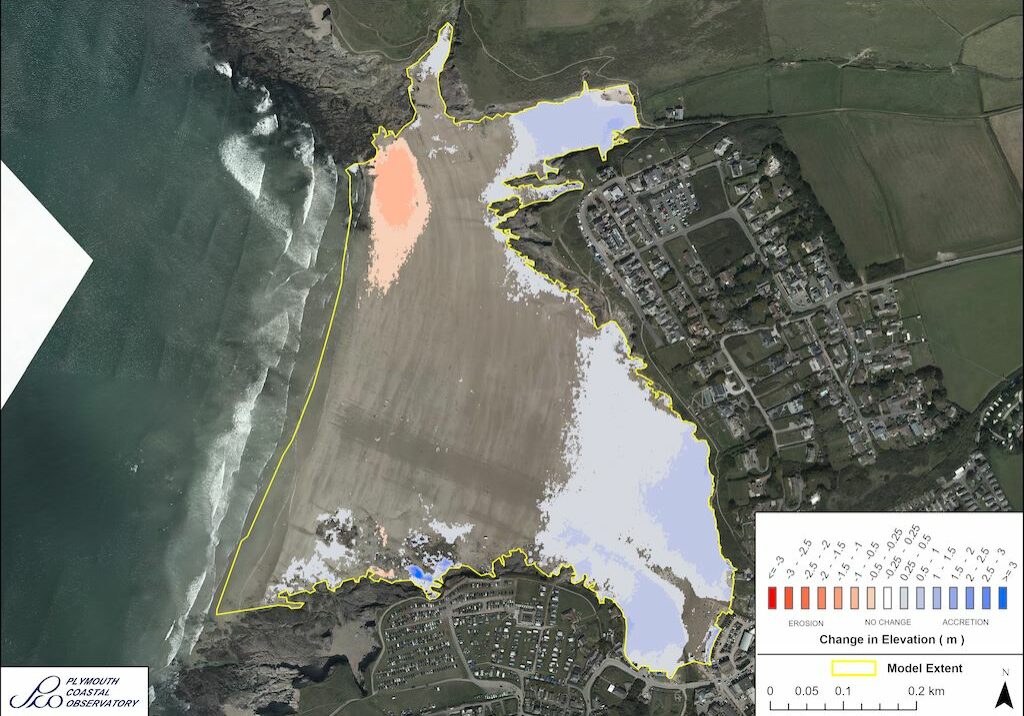
Polzeath (Cornish: ‘Pollsygh’, meaning ‘dry creek or pool’) is a west facing bay at the mouth of the Camel Estuary in north Cornwall. Two streams run onto the site, the Pentireglaze Stream, which flows onto Pentireglaze Haven, to the north of the Polzeath and Polzeath Stream, which flows onto the south side of Polzeath through the village of Polzeath.
Polzeath is a wide embayed beach, fringed by low cliffs to the north and south. The beach is confined during high tide, but as the tide drops the retreating waters expose a broad area of fine, flat, golden sand, which see’s Polzeath Beach merge with Cockett haven, Pentireglaze Haven and Pentire Haven, which are collectively sometimes referred to as Hayle Bay.
Though much of the village of Polzeath and New Polzeath has developed on more resilient cliffs, the heart of the village, with its shops and restaurants, is located in a low-lying area, more vulnerable to storm surges and coastal change. As sea levels rise, the beach car park and other structures on the uppershore of the beach, will increasingly become more vulnerable.


Coastal Changes
The coastline of Cornwall is an ever-changing environment. It is energetic, dynamic, never still and changes with each wave and each tidal cycle. Some of the changes we see are gradual and barely noticeable, whilst others, such as rockfalls, happen suddenly and often shockingly.
From one visit to the next it can sometimes be difficult to see how a beach and dune system has changed, but information has been collected, and is being collected through the Making Space for Sand project, to help us better understand how the coastline is changing. The purpose of this section of the website is to understand each location has changed over time, how it could change in the future and understand the policies that influence how we can respond to these changes.
Shoreline Management Plan (SMP)
The Shoreline Management Plan (SMP) is a strategic planning and management assessment tool that helps identify and measure the risk associated coastal erosion and coastal flooding. The document makes a number of policy recommendations over short, medium and long term timeframes setting out a strategic approach to managing the built, natural and historic environments associated with the coastline. Within SMP there are four policy approaches which have been assigned to stretches of coastlines. The four policies are: No Active Intervention (NAI), Hold the Line (HTL), Managed realignment (MR), and Advance the line (ATL).
Polzeath sits within Policy Development Zone 14 (PDZ4), in Management Area 36 (MA36), within Policy Units (PU) 36.1, 36.2, 36.3 and 36.4. The policy recommendations for these policy units are detailed in the table below and the SMP can be accessed through the Cornwall Council website.
Use your touchscreen
to scroll the below table
| Policy Unit | SMP2 Policy Plan | |||||
| 2025 | 2055 | 2105 | Comment | |||
| 36.1 | Undefended cliffs
Main Policy Sub Policy |
NAI DnD |
NAI DnD |
NAI DnD |
This approach best meets the objectives of the landscape and environmental designations and allows the natural evolution of the coast. | |
| 36.2 | Polzeath
Main Policy Sub Policy |
HTL RnR |
MR P |
MR P |
The policy intent is to support the viability of and core values of the settlement along with the economic benefits that the town and the beach bring to the area. However, the current position on the town is unsustainable.
As such, the current policy of hold the line will be continued for the first epoch, with a policy of managed realignment from the second epoch to move the access road back to a more sustainable position. Realignment of this road is necessary to maintain the integrity of the community as a whole. Relocation of the commercial stores and Post Office would be necessary under this policy, which would remove them from flood and erosion risks to more sustainable positions. With the predicted coastal change affecting the commercial centre of the village, the principal tourist car parks, and potentially the more southerly caravan site, the Land Use Planning system should consider identifying a Coastal Change Management Area for Polzeath. |
|
| 36.3 | New Polzeath
Main Policy Sub Policy
|
NAI LAO
|
NAI LAO |
NAI LAO |
This approach best meets the objective to allow the natural evolution of the shoreline to occur to support conservation of designated features. Monitoring of erosion rates at Crockett Haven should be undertaken to confirm the predicted erosion rates upon which this policy choice is based. This policy allows local activity to maintain access to the beach over the long term, the approach to which may require investigation. | |
| 36.4 | Pentireglaze Haven
Main Policy Sub Policy |
NAI DnD |
NAI DnD |
NAI DnD |
Allow natural coastal evolution to occur. It is unlikely that there would be a positive benefit cost ratio to enable any coast protection works at this location. Properties not expected to be affected until third epoch.
|
|
| Key Main Policy: HTL - Hold the Line, A - Advance the Line, NAI – No Active Intervention, MR – Managed Realignment
Sub Policy: DnD – Do not Defend – Repair not Replace, P – Place Holder, LAO – Local Activity Only. |
||||||


National Coastal Erosion Risk Mapping (NCERM)
National Coastal Erosion Risk Mapping (NCERM) provides a baseline of coastal erosion, for the coastline of England, over short, medium and long-term timeframes. The data is based on the natural and defence characteristics of the coastline and provides rates of erosion at differing levels of confidence to help better plan for worse case scenarios. The data provided is for guidance and does not estimate the absolute location of the future coastline.
The basic NCERM lines show erosion estimates for the Short Term (ST-20 years), Medium Term (MT-50 years) and Long Term (LT- 100 years). The data is further categorised by probability: 05 is 5% probability (a 1 in 20 chance of being exceeded) Red Shading, 50 is 50% probability of being exceeded (a 1 in 2 chance of being either exceeded or not exceeded) Orange Shading and 95 is 95% probability (a 19 in 20 chance of being exceeded) Yellow Shading. Click the link below to access the Cornwall Council NCERM Mapping site read the about section then click on layers.

Historical Images of Polzeath
Historical photographs provide a powerful insight into how the Cornish coastline has changed within the past Century. The Making Space for Sand project are working in collaboration with the Francis Frith collection and have been given permission to share historical images on a number of beaches considered within the project.
In looking back, we can better understand how the coastline has changed, helping us understand not only how the coastal fringe has developed but also the potential future changes that we my observe. When this is considered alongside forecasts of coastal erosion and sea level rise it will help enable us to better adapt to our changing coastline.
Polzeath beach in 1938 (Courtesy of the Francis Frith collection) and in 2023.
Polzeath beach from New Polzeath in 1960 (Courtesy of the Francis Frith collection) and in 2023.
Polzeath village from Dunders Hill in c1960 (Courtesy of the Francis Frith collection) and in 2023.


Modelling Coastal Change
Using data that has already been collected, combined with data collected through the Making Space for Sand project, a series of models will be carried out at each location. This will help us better understand how each location may respond to sea level rise and gain a deeper understanding of how coastal sediments move and behave.
The complexity of the modelling, and the data collection that helps inform it, means that modelling outputs will not be the same on all sites. Some locations will be more thoroughly investigated to understand more complex issues and provide data that can be more widely applied to other sites with similar characteristics.
As the project develops this section of the website will expand, sharing new reports and coastal change projections when they are produced.
LiDAR surveys, which are explained on the Data Modelling page, have been carried out by the South West Coastal Monitoring program at this location. The image shared here visualises where sand has eroded (areas shaded in red) and where it has built up (areas shaded in blue), between the LiDAR surveys carried out in 2003 and 2019. The darker the shade of red or blue the greater the amount of sand erosion or accumulation has been observed. The image helps visualise that beaches are areas that change shape over time and will continue to do so as sea levels rise.


Designations
The coastline represents an important transition between the marine environment and the terrestrial environment. This transition creates a range of special habitats and exposes a range of interesting features, which that can result in these spaces being highly designated and protected. There are a range of designations that recognise a variety of different features. At this location these designations are explored below.
Site of Special Scientific Interest (SSSI)
A Site of Special Scientific Interest or SSSI is a statutory conservation designation notified by Natural England denoting protection for biological and/or geological characteristics. The natural wildlife and geological features of SSSI’s are considered to be irreplaceable parts of the national heritage. These are protected in order to preserve their importance, and to prevent damage and development.
Polzeath sits between the Pentire Peninsula SSSI to the north and the Trebetherick Point SSSI to the south.
Image of the mouth of the Camel Estuary
The Pentire Peninsula SSSI
The Pentire Peninsula SSSI covers an area of 113.7 hectares between Pengrit Cove to the east of Pentire Point to Tristam Cove. The rock outcrops of the peninsula exposes the unique folding ‘Polzeath Confrontation’ and pillow lavas and mudflow conglomerates (rock fragments set in a fine muddy matrix). The soils of the peninsula supports a rich and diverse flora, supporting a mosaic of maritime grassland, healthland and scrub.
Image of the one of the many rockpools associated with Polzeath
Trebetherick Point SSSI
The Trebetherick Point SSSI covers an area of 68.1 hectares between Greenaway Beach to the south eastern edge of Rock dunes. The geology of the area is important for more recent geological activities in the Quaternary Period, providing evidence of raised beaches and boulderbeds, which are thought to have been deposited by glacial activity. Daymer Bay contains excellent exposures of fossil rich slates, which are important for dating purposes. The area boasts diverse grassland and dune habitats rich in flora and fauna.
Image of sea Knotgrass in a sand dune
Designated Cornwall National Landscape Area
From November 2023, all areas previously know as Areas of Outstanding Natural Beauty, or AONBs, were re-named National Landscape and in Cornwall became Cornwall National Landscape. However, the Management Plan still references the term AONB as this was formally adopted by Cornwall Council and cannot be amended until the next plan is produced.
Cornwall National Landscape areas are protected landscapes whose distinctive character and natural beauty are so outstanding that it is in the nation’s interest to safeguard them. As such they have been nationally designated by the same legislation as National Parks and have the same status and level of protection.
The Pentire Point to Widemouth section covers an area of 11,879 hectares, which is 12.3% of the total Cornwall National Landscape. The key landscape characteristic of this section is the coastline, which throughout this section is craggy with dramatic contorted cliffs and folded slates, shales and volcanic rocks with some sandstone to the north.
Image of photographers at sunset at Trebarwith Strand (Courtesy of Myles Pinkney)
Sign up to Making Space for Sand
If you would like to get involved in helping to make dunes more resilient and biodiverse, want to help develop coastal adaptation and emergency plans or just want to know more about what the project is learning about coastal change, please click here:








